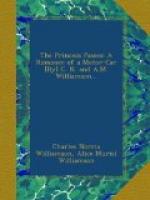“Molly’s so keen on the Maid,” said he, “that she can’t forgive Rouen for not really being the scene of the trial and burning. But never mind, since she wills it, we’ll shake the dust off our Michelins, and when we’re outside, you will have got far enough in your motoring lesson, I think, to try driving.”
What the last hour had not taught me (thanks to him) in theory of coils and accumulators, electromagnets and other things, was scarcely worth learning. I seemed to have looked through glass walls into the cylinders, at the fussy little pistons working under control of the “governor,”—a tyrant, I felt sure. I had already formed a mature opinion on the question of mechanically operated inlet valves (which sounded disagreeably surgical), and was able to judge what their advantage ought to be over those of the old type worked by the suction of the piston. I could imagine that more than half the fun of owning a motor car would lie in understanding the thing inside and out; and I said so.
“It’s a little like controlling the elements,” Jack answered. “Think of the difference in this machine, when it’s asleep—cold and quiet, an engine mounted on a frame, a tank of water, a reservoir of cheap spirit, a pump, a radiator, a magnet, some geared wheels fitting together, a lever or two. My man twists a handle. On the instant the machine leaps into frenzied life. The carburetter sprays its vapour into the explosion chamber, the magnet flashes its sparks to ignite it, the cooling water bathes the hot walls of the cylinders—a thing of nerves, and ganglions, and tireless muscles is panting eagerly at your service. You move this lever, you press your foot lightly on this pedal; the engine transfers its power to the wheels; you move. The carriage with you and your friends is borne at railway speed across continents. You can hurl yourself at sixty miles an hour along the great highroads, you can crawl like a worm through the traffic of cities.”
By the time Jack had finished this harangue we had climbed the hill out of Rouen and were on the fine but accidente highroad that leads past Boos and Pont St. Pierre. Soon we would reach Les Andelys and Chateau Gaillard. Still Jack was not quite ready to let me put my newly acquired knowledge into practice. There was a hill of some consequence before Mantes, which we had to reach by way of La Roche Guyon and Limay. After that there would be only what the route book calls “fortes ondulations”; and under the stronghold of Lion Heart himself (an appropriate spot, forsooth!), I was to try my hand at dragon-driving.
Winston brought the car to a standstill at the foot of the mouldering ruins of Richard’s “Saucy Castle,” and as we looked up at the towering battlements, the huge flanking towers, and the ponderous citadel, the dark mass on its lofty rock set in the sunny landscape like a bloodstone in a gold ring, seemed to be an epitome in stone of life in the Middle Ages.




